Fieseler Fi 156 Video - Newsreel of first flight
|
|
Fieseler Fi 156
Fi 156 Storch
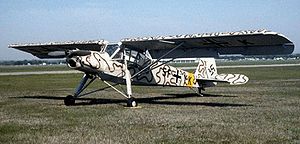
Role: Reconnaissance & communications
Manufacturer: Fieseler, Morane-Saulnier
Designed by: H Winter
First flight: 1936
Introduced: 1937
Retired: 1945 (Germany), 1970 (France)
Primary users: Luftwaffe
Aviation Légx¨re de l’Armée de Terre, Armée de l'Air
Produced: 1937-1949 (1965 for the MS 500)
Number built: Over 2,900
The Fieseler Fi 156 Storch (stork) was a small German liaison aircraft built by Fieseler before and during World War II, and production continued in other countries into the 1950s for the private market. It remains famous to this day for its excellent STOL performance, and French-built later variants often appear at air shows.
Conception and production
Design and development
In 1935, the RLM (Reichsluftfahrtministerium, Reich Aviation Ministry) put out a tender for a new Luftwaffe aircraft suitable for liaison, army co-operation (today called Forward Air Control), and medical evacuation, to several companies. Conceived by chief designer Reinhold Mewes and technical director Erich Bachem, Fieseler's entry was by far the most advanced in terms of STOL (Short Take Off and Landing) performance. A fixed slat ran along the entire leading edge of the long wings, while the entire trailing edge, inspired by earlier 1930s Junkers "double-wing" aircraft wing control surface designs, including the ailerons, was a hinged and slotted flap.
In a design feature rare for land-based aircraft, the wings on the Storch could be folded back along the fuselage in a manner not unlike that of the US Navy's F4F Wildcat fighter, allowing it to be carried on a trailer or even towed slowly behind a vehicle. The primary hinge for folding the wing rearwards was located in the wing root, where the rear wing spar met the cabin area. The long legs of the main landing gear contained oil-and-spring shock absorbers that compressed about 450 mm (18 inches) on landing, allowing the plane to set down almost anywhere. In flight they hung down, giving the aircraft the appearance of a very long-legged, big-winged bird, hence its nickname, Storch. With its very low landing speed the Storch often appeared to land vertically, or even backwards, in strong winds from directly ahead.
German production
A total of about 2,900 Fi 156s, mostly Cs, were produced from 1937 to 1945 at the Fieseler Factory in Kassel. In 1942 the production started in the Morane-Saulnier factory at Puteaux in France. Due to the demand for the Bf 109 and the Fw 190, the Storch production was shifted to the Leichtbau Budweis in Budweis in 1943.
Czech production
In 1944 the production was moved from the Leichtbau Budweis to the Mrx¡z factory in Chocen which produced 138 examples of Fi 156, locally designated as K-65 ÄŒx¡p. Production ended in 1949.
French production
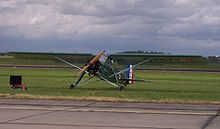
Picture - Morane-Saulnier MS.505 Criquet
Immediately after the liberation of France in 1944, the production of Storch at the Morane-Saulnier factory was continued at the request of the Armée de l'Air and designated MS 500 for the batch of aircraft produced with the remaining stock of Argus engines. Further modification and use of different engines (inline and radial) are known under different type. The use of the plane in Indochina highlighted the weakness of the wood in the construction of the airframe; It was then decided to build the wings in metal. Among the modifications, the defensive weapon aiming through the back window was dropped, although some aircraft have then been modified on the field to take a Machine Gun MAC 34T firing through one of the side window. 141 aircraft were built before the end of WWII and a total of 925 aircraft were built before the end of the production of all type of Criquet by Morane-Saulnier in 1965.
Romanian production
Licence production was also started in Romania in 1943 at the ICAR factory in Bucharest. Only 10 were built by the time Romania switched sides, with a further 70 aircraft being built by the Romanians before production ended in 1946.
Summary of production
Production per factory and per type until 31 March 1945:
Further development
Because of its superb STOL characteristics (which would be of obvious great benefit to bush pilots, for example) there have been many attempts to recreate or outright copy the Storch in modern form, namely in the form of various homebuilt aircraft.[1] One of the most successful recent examples of this is the Slepcev Storch designed by Nestor Slepcev. It is a 3/4 scale reproduction of the original with some modification for simplicity. Through the use of modern materials the aircraft features better STOL performance than the original with a take-off run of 30 m and landing-roll of 50 m with no headwind.
Operational history
During WWII

Picture - Fi 156 in Luftwaffe markings
The Storch could be found on every front throughout the European and North African theaters of operation in World War II. It will probably always be most famous for its role in Operation Eiche, the rescue of deposed Italian dictator Benito Mussolini from a boulder-strewn mountain top near the Gran Sasso, surrounded by Italian troops. German commando Otto Skorzeny dropped with 90 paratroopers onto the peak and quickly captured it, but the problem remained of how to get back off. A Focke-Achgelis Fa 223 helicopter was sent, but it broke down en route. Instead, pilot Walter Gerlach flew in a Storch, landed in 30 m (100 ft), took aboard Mussolini and Skorzeny, and took off again in under 80 m (250 ft), even though the plane was overloaded. The Storch involved in rescuing Mussolini bore the radio code letters, or Stammkennzeichen, of "SJ + LL" in motion picture coverage of the daring rescue.
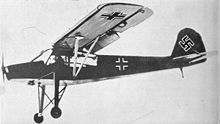
Picture - Fi 156 in flight
On 26 April 1945 a Storch was one of the last planes to land on the improvised airstrip in the Tiergarten near the Brandenburg Gate during the Battle of Berlin and the death throes of the Third Reich. It was flown by the test pilot Hanna Reitsch, who flew her lover Field Marshal Robert Ritter von Greim from Munich to Berlin to answer a summons from Hitler. Once in Berlin von Greim was informed that he was to take over command of the Luftwaffe from Hermann Gx¶ring.
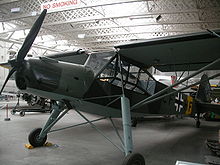
Picture - Restored Storch in IWM Duxford
A Storch was the victim of the last dog fight on the Western Front and another was downed by a direct Allied counterpart of the Storch - an L-4 Grasshopper - from the L-4's crew directing their pistol fire at it. The pilot and co-pilot of the L-4, Lts. Duane Francis and Bill Martin, opened fire on the Storch with their .45 caliber pistols, forcing the German air crew to land and surrender.
During the war a number of Storchs were captured by the Allies; the British having captured 145 from which 64 were given to the French as War compensation from Germany, one becoming the personal aircraft of Field Marshal Montgomery.
Post WWII
The ALA and the ALAT use the Criquet from 1945 to 1958 throughout the Indochina War and the Algerian War.
Variants
Fi 156 V1 - Prototype equipped with an adjustable metal propeller, registration D-IKVN (produced in 1935-1936)
Fi 156 V2 - Prototype equipped with a Wooden propeller. First Prototype to fly (May 10, 1936). registration D-IDVS (produced in 1935-1936)
Fi 156 V3 - Prototype identical to the V2. Test machine for various radio equipment, registration D-IGLI (produced in 1936)
Fi 156 V4 - Prototype identical to the V3. Skis for landing gear and disposable auxiliary tank. (produced in 1936-1937)
Fi 156 V5 - Production prototype for A-series. (produced in 1937)
Fi 156 A-0 - Pre-production aircraft, identical to the V3. Ten aircraft were produced. (produced in 1937-1938)
Fi 156 A-1 - first production models for service, ordered into production by the Luftwaffe with an order for 16 aircraft, the first production aircraft entered service in mid-1937. Some source cite only 6 were effectively produced. (produced in 1938)
Fi 156 B - Allowed for the automatic retraction of the leading edge slats and had a number of minor aerodynamic cleanups, boosting the speed to 208 km/h (130 mph). The Luftwaffe didn't consider such a small difference to be important and the Fi-156 B was not produced.
Fi 156 C-0 - Pre-production. Essentially a "flexible" version of the A model. (produced in 1939)
Fi 156 C-1 - three-seater liaison version. (produced in 1939-1940)
Fi 156 C-2 - two-seat observation type (which had a rear-mounted MG 15 machine gun for defense), produced in 1940.
Fi 156 C-3 - Replaced the C-1 and C-2 with a "universal cockpit" suited for any role. (produced in 1940-1941)
Fi 156 C-3/Trop - Version adapted for tropical/desert conditions. Filtered intakes. (produced in 1940-1942)
Fi 156 C-5 - Addition of a belly hardpoint for a camera pod or jettisionable auxiliary tanks. Some were fitted with skis, rather than wheels, for operation on snow. (produced in 1941-1945)
Fi 156 C-5/Trop - Version adapted for tropical/desert conditions. Filtered intakes. (produced in 1941-1945)
Fi 156 D-0 - Pre-production of the air ambulance version of the C model with a larger cockpit and larger doors. Powered by an Argus AsP engine. (produced in 1941)
Fi 156 D-1 - Production version of the D-0. (produced in 1942-1945)
Fi 156 E-0 - Liaison version identical to the C-1 Ten pre-production aircraft were fitted with tracked landing gear. (produced in 1941-1942)
Fi 156 F or P - Counter insurgency version. Identical to the C-3 with machine guns in side windows and bomb-racks/smoke laying. (produced in 1942)
Fi 156 U - Anti-submarine version. Identical to the C-3 with depth charge. (produced in 1940)
Fi 156 K-1 - Export version of the C-1 (Bought by Sweden).
Fi 256 - A five seat civil version; two were built by Morane-Saulnier.
MS-500 - Liaison version. French produced with 240 hp French built Argus engine.
MS-501 - with a 233 hp Renault 6Q
MS-502 - Liaison version. Identical to the MS-500, with the Argus engine replaced by a 230 hp Salmson 9ab radial engine.
MS-504 - with a 304 hp Jacobs R-755-A2 radial engine.
MS-505 - Observation version of the MS-500 with the Argus engine replaced by a 304 hp Jacobs R-755-A2 radial engine.
MS-506 - with a 235 hp Lycoming engine.
Mrx¡z K-65 ÄŒx¡p - production in Czechoslovakia after WWII.
Antonov OKA-38 - An unlicensed copy of the Fi 156, powered by a copy of a Renault MV-6 engine, was starting production as the factory was overrun by German forces in 1941
Operators
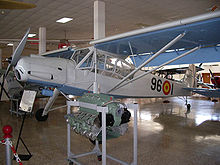
Picture - Spanish Air Force Fi 156 and Argus As 10 engine
Bulgaria
Cambodia (Post war)
Croatia
Czechoslovakia (Post war)
Finland - Finnish Air Force
France - French Air Force and French Army (Post war)
Germany - Luftwaffe
Greece (Post war)
Hungary
Italy
Laos (Post war)
Norway (Post war)
Poland (Post war)
Romania
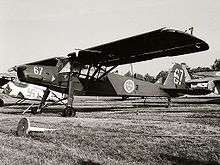 Slovakia
Slovakia
South Vietnam - Vietnam Air Force (Post war)
Soviet Union
Spain - Spanish Air Force
Sweden - Royal Swedish Air Force
Switzerland - Swiss Air Force
Picture - Swedish Air Force S14 (Fi 156)
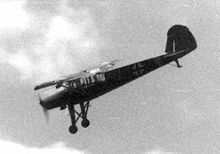
Picture - Rudolf Langhanns collection
United Kingdom - Royal Air ForceSpecifications (Fi 156)
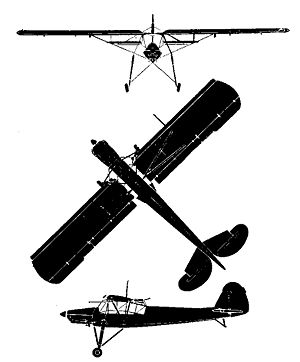
Picture - Morane-Saulnier M.S.500 Criquet
General characteristics
Crew: 2
Length: 9.9 m (32 ft 6 in)
Wingspan: 14.3 m (46 ft 9 in)
Height: 3.1 m (10 ft 0 in)
Wing area: 26 m² (280 ft²)
Empty weight: 860 kg (1,900 lb)
Loaded weight: 1,260 kg (2,780 lb)
Powerplant: 1x— Argus As 10 air-cooled inverted V8 engine, 180 kW (240 hp)
Performance
Maximum speed: 175 km/h (109 mph) at 300 m (1,000 ft)
Range: 380 km (210 nmi, 240 mi)
Service ceiling: 4,600 m (15,090 ft)
Rate of climb: 4.8 m/s (945 ft/min)
Wing loading: 48.5 kg/m² (9.9 lb/ft²)
Power/mass: 143 W/kg (0.087 hp/lb)
Armament
Guns: MG 15 machine gun
Related development
Antonov OKA-38 Aist
Fieseler Fi 97
Pazmany PL-9 Stork a ¾ scale variant for homebuilders
Comparable aircraft
Aero L-60 Brigadýr
Dornier Do 27
Helio Courier-postwar (1949) American light STOL aircraft
Ikarus Kurir
Kobeseiko Te-Go
Kokusai Ki-76 "Stella"
Meridionali Ro.63
Messerschmitt Bf 163
Piper L4
Polikarpov Po-2
Siebel Si 201
Vultee L-1A Vigilant
Westland Lysander
Bibliography
Axworthy, Max. "On Three Fronts: Romania's Aircraft Industry During World War Two". Air Enthusiast, No.56, Winter 1994. Stamford, Lincs, UK:Key Publishing. ISSN 0143 5450. pp8-27.
Bateson, Richard P. "Fieseler Fi 156 Storch". Aircraft in Profile, Volume 11. Widsor, Berkshire, UK: Profile Publications Ltd., 1972.
Dariusz KARNAS & Pawel PRZYMUSIALA, Fi 156 Storch Vol.1 (Militaria n.68), Wydawnictwo, Warsaw, 1998, ISBN 83-7219-019-4
Dariusz KARNAS & Pawel PRZYMUSIALA, Fi 156 Storch Vol.2 (Militaria n.100), Wydawnictwo, Warsaw, 1999, ISBN 83-7219-059-3
Philippe RICCO & Jean-Claude SOUMILLE, Les Avions Allemands aux Couleurs Francaises, Tome 1, Airdoc, Rochemaure, 1997, ISBN 29-5094-855-3, ISBN13 978-29-5094-855-7
Jean-Claude SOUMILLE, L'Aviation Francaise en Indochine 1946-1954, Tome 2, Airdoc, Rochemaure, 1997, no ISBN
Fieseler Fi 156 Pictures and Fieseler Fi 156 for Sale.
Living Warbirds: The best warbirds DVD series.
Source: WikiPedia